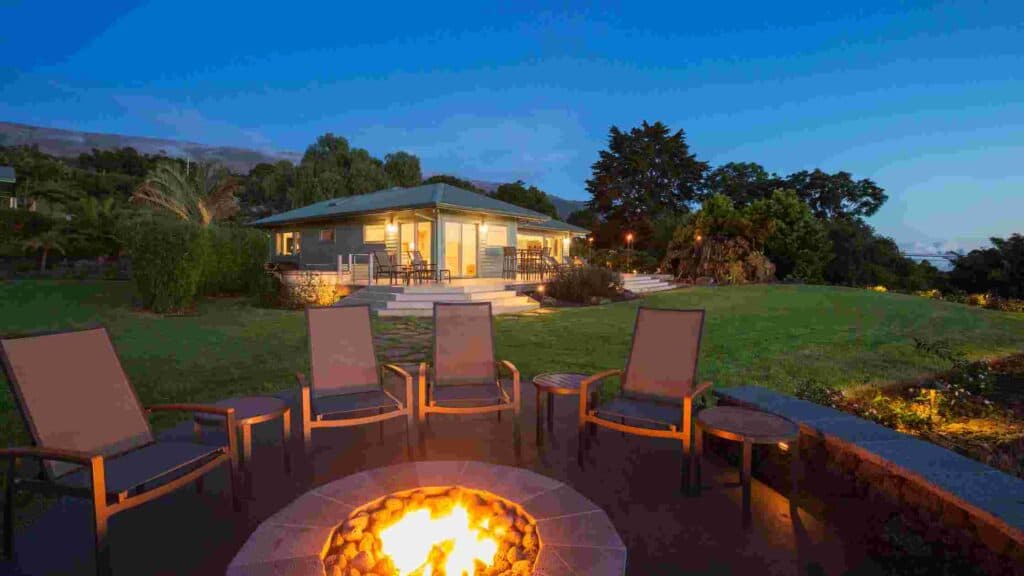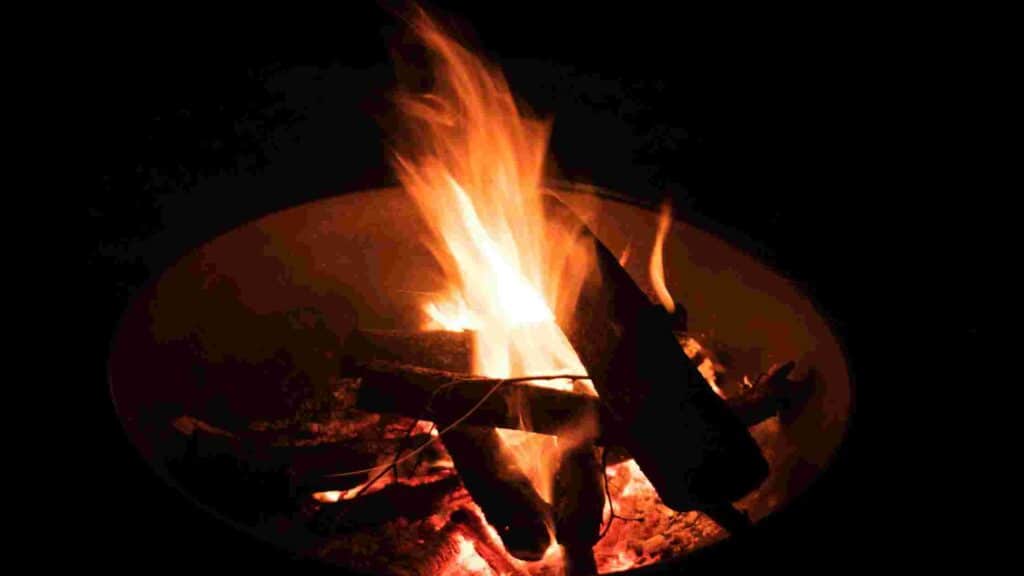Starting a fire in a fire pit may seem simple, but there’s an art to it if you want to embrace the traditional approach. Safety should always be a top priority when learning how to start a fire in a fire pit.
By mastering the technique of igniting a fire using quality kindling and tinder, you can steer clear of lighter fluid or flammable liquids and enjoy the warmth and coziness of a crackling fire with your friends, creating cherished memories.
How To Start A Fire In A Fire Pit: Brief Overview
Before placing firewood inside your fire pit, it’s important to ensure the interior is dry. Moisture tends to accumulate, especially when fire pits are left outdoors. Give the inside a wipe-down using paper or cloth.
Now, gather the essential components: kindling, tinder, and fuel. Ensure the kindling and tinder are dry. Items like dry pine needles, newspapers, and straw work wonders as excellent tinder for kickstarting a fire in your fire pit.
Kindling typically consists of thick sticks or twigs, playing a crucial role as fire starters. They should burn long enough for the fire pit logs to catch fire.
To build up the heat effectively, begin with a layer of smaller diameter timber pieces. Fuel the larger firewood that sustains the fire. Make sure it is dry and not green, as green wood doesn’t burn well in the fire.
Fire pits rely on oxygen to keep the flames alive. If you stack your firewood in a way that allows proper airflow, your fire is more likely to thrive.
For starting your fire, consider two popular designs: the log cabin design or the teepee design for arranging the kindling. These designs facilitate airflow, allowing the fire to breathe and burn steadily (check out the best outdoor fire pit ideas).
Welcoming Guests With A Pre-Lit Fire Pit

Here’s a pro tip: aim to have the fire already burning before your guests arrive. The sight of a beautiful wood-burning fire in the fire pit sets a warm and welcoming atmosphere, instantly making your guests feel at home.
Additionally, the aroma of an open fire adds a delightful touch to the ambiance, creating an inviting space for everyone to gather around.
Ensuring A Secure Environment
When it comes to campfires or fire pits, fire safety is of utmost importance (learn how to make a bonfire pit). Before igniting a blaze in your fire pit, take a moment to check the local weather forecast.
Avoid using your fire pit on exceptionally windy days, as strong gusts can make it challenging to light the kindling and may blow sparks toward surrounding vegetation or structures. Even high humidity levels can make it harder to create and sustain a fire.
Never position your fire pit beneath the overhang of a building or near trees. Clear the immediate area around the fire pit of any yard waste or flammable materials.
Maintain a safe distance between chairs and the fire pit, and always tie back your hair and roll up your sleeves when tending to the fire. It’s crucial to teach children the “stop, drop, and roll” technique in case their clothing catches fire.
To start your fire, opt for long safety matches or a long-nosed lighter to ignite the newspaper and kindling. Steer clear of using lighter fluid as a fire pit fire starter. Regardless of the flame’s size, continuously monitor the fire and be prepared to extinguish it promptly if necessary.
When having an outdoor fire, always keep a water and shovel nearby, just in case. For added safety measures, consider investing in a fire blanket, which can swiftly smother a blaze.
What’s The Best Fuel For Your Fire Pit?
When it comes to fueling your fire pit, choosing the right type of wood can make all the difference. Seasoned firewood stands as a superior option compared to green firewood, which is freshly cut.
Seasoned firewood undergoes a drying process, allowing the moisture from the tree’s cells and sap to evaporate, resulting in timber that is ready to burn.
To be considered fully seasoned, the moisture content should be below 20 percent, which requires a significant amount of time to achieve.
Seasoned Firewood: The Superior Fire Starting Wood
To properly season firewood, it should be cut into manageable pieces and stacked in a dry location, perhaps in a well-constructed log cabin shape. The wood should be left to dry for approximately a year.
When you handle properly seasoned firewood, you’ll notice that it is lighter and harder compared to green wood. Moreover, seasoned wood tends to burn more efficiently, reducing the amount of consumption required.
How To Light A Fire Pit Without Smoke
While seasoned firewood is generally the ideal choice, it’s worth noting that not all firewood suppliers can provide adequate shelter for the wood. Even if the wood has lost its green color, it may not be suitable for creating a clean-burning fire in your fire pit or campfire.
Wood that has been exposed to frequent rain may dry on the outside but harbor mold and fungus in the center of the pile. Poorly seasoned wood is notorious for producing excessive smoke when burned.
In addition, certain wood types containing pitch or sap, as well as improper stacking of wood during the fire-building process, can contribute to increased smoke output. To ensure a successful fire start, always remove any embers, old ash, or debris from your fire pit before igniting a new fire.
An Alternative: Kiln-Dried Firewood
An optional alternative to seasoned firewood is kiln-dried wood. Kiln-dried firewood goes through a process where the moisture is removed using specialized kilns. The harvested timber is debarked, sorted into similar types, shapes, and sizes, and then dried in batches until it reaches equal moisture levels.
Kiln-dried firewood is ready to burn immediately in your fire pit, and due to its low moisture content, it produces minimal smoke. Additionally, the high-heat production process eliminates insects and mold from the wood.
However, it’s important to note that kiln-dried wood can be more expensive to purchase due to the involved processes. If you opt for kiln-dried wood, ensure you have a dry place to store it, or order only what you expect to use in the near term.
Starting The Fire: Tinder, Kindling, And Firewood

To start your fire, begin by placing the tinder in a small pile at the bottom of the fire pit, and create a teepee-like structure with the kindling over the tinder.
Light the tinder to ignite your fire, and once the kindling is burning steadily, gradually add kiln-dried or seasoned firewood logs one at a time. Introduce smaller pieces of wood as the fire grows, allowing the heat to build up.
When arranging your firewood, maintain a similar structure to your kindling arrangement, such as a teepee or pyramid shape.
Keep the firewood close enough to concentrate the fire while leaving small gaps to maximize airflow. If the firewood struggles to catch fire or the flame starts to dwindle, try adding additional tinder and kindling to revive it.
Choosing The Right Wood Types
For an effective fire starter, opt for softwood varieties such as juniper, pine, spruce, or balsam. Softwoods burn intensely for shorter periods, making them ideal for getting your fire going (you may also be interested in checking out how to light a gas fire pit).
Once the fire is well underway, turn to properly seasoned hardwoods, as they burn longer and hotter compared to softwoods (check out: how hot does a fire pit get?).
Understanding the characteristics of the wood you’re working with and its seasoning requirements will help you create the perfect fire in your fire pit.
FAQs – How To Build A Fire In A Fire Pit
1. How do you start and keep a fire going in a firepit?
To start and keep a fire going in a fire pit, begin by arranging small pieces of dry kindling in the center of the pit. Place firewood logs on top in a crisscross pattern.
Use a fire starter or newspaper beneath the kindling and light it. Gradually add larger pieces of firewood to maintain the fire, and periodically stoke it by gently shifting the logs.
2. How do you start a fire pit with real wood?
To start a fire pit with real wood, gather dry, seasoned firewood and arrange it in the fire pit. Create a small pile of tinder or kindling, such as twigs, small branches, or newspaper, in the center.
Light the tinder using matches or a lighter, and once it catches fire, carefully add more kindling and firewood to build up the fire.
3. How to start a fire in a fire pit without lighter fluid?
To start a fire in a fire pit without lighter fluid, use alternative fire starters like dry leaves, twigs, or commercially available fire starters.
Arrange small pieces of kindling and build a pyramid shape. Ignite the fire starter in the center and gradually add more kindling and firewood to keep the fire going.
4. How to start a fire pit with sticks?
To start a fire pit with sticks, gather dry sticks and twigs of varying sizes. Arrange the smaller twigs in a tepee shape and place tinder or dry leaves in the center.
Rub two sticks together using a friction-based fire-starting method, such as the bow drill or hand drill, to create a spark that ignites the tinder. Gradually add more sticks and twigs to build up the fire.
5. How to put out a fire in a fire pit?
To put out a fire in a fire pit, carefully pour water over the flames, starting from the edges and moving towards the center. Stir the ashes and embers with a shovel or stick to ensure everything is thoroughly soaked.
Continue adding water and stirring until there are no more signs of smoldering or heat. Avoid leaving the fire pit unattended until it has completely cooled down.
You might also be interested in checking out the article on how to put out a fire pit.
Conclusion: Best Way To Start A Fire In A Fire Pit
By selecting the best fuel for your fire pit—whether seasoned or kiln-dried firewood—and following proper fire-starting techniques, you’ll be well on your way to enjoying a cozy and crackling fire in your outdoor space.
So, gather your loved ones, embrace the warmth, and let the mesmerizing flames create unforgettable moments.
You might also be interested in checking out the best fire pit cooking grates.
